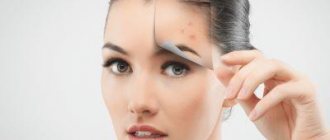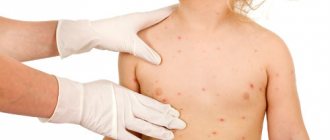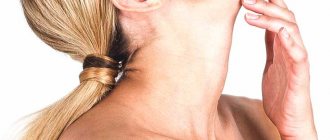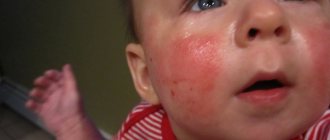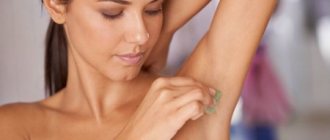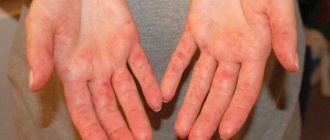The neck is one of the most sensitive parts of the body. The skin in this area is characterized by increased sensitivity to various irritating factors, and this is where the rash most often occurs. In a small child, susceptibility to various irritants is much higher than in an adult; rashes on the neck, shoulders and behind the ears can indicate both a reaction to insufficient care and a serious illness. A rash on the neck of a child requires mandatory medical consultation.
Prickly heat
If your baby has a small red rash, he most likely has heat rash. Pathology is not a disease in the full sense of the word, it is an irritation that occurs on the face, neck, shoulders and other parts of the body as a result of constant contact of delicate baby skin with sweat and moisture.
Miliaria usually forms during the hot season, as well as in cases when the baby receives insufficient care and remains in dirty diapers for a long time.
Miliaria differs from other pathologies that cause a rash, because it causes only mild discomfort and is not accompanied by other unpleasant symptoms.
The condition does not require special treatment; it is enough for parents to provide their child with quality care, in particular:
- Regularly bathe your child using baby soap. It is necessary to carefully treat the face, the areas behind the ears, and the neck in front and behind. Baby soap slightly dries wet skin, and thereby helps eliminate the rash.
- Dust the baby's neck with special baby powder or talcum powder.
Seborrheic dermatitis in adults
The sebaceous glands give the skin special softness and elasticity, but if they function excessively, fungi can actively develop. This disease mainly occurs in women, and this occurs due to a sharp decrease in female hormones in the body. The disease also occurs as a result of uncontrolled use of hormonal drugs, lack of vitamins, as well as the presence of chronic diseases.
The disease is characterized by severe skin itching and rashes. Mostly the rash appears on the back of the head, behind the ears, and on the scalp. This disease cannot always be identified at the initial stage, but it is worth noting that it progresses very slowly. Symptoms such as:
- skin irritation;
- redness of the skin;
- peeling with the formation of white and yellow spots;
- severe sensitivity and pain in the affected area.
Some parts of the body may become wet, resulting in ulcers and cracks in the skin. If comprehensive treatment is not carried out in a timely manner, the hair will gradually begin to fall out, which threatens baldness. When making a diagnosis, the doctor takes into account the patient’s interview data, as well as clinical data obtained during the examination.
The approach to treatment must be comprehensive, since initially it is necessary to eliminate the clinical manifestations of dermatitis, as well as get rid of the factors that provoked the problem.
Allergic reactions
Allergies are the second most common cause of rashes on a child’s body. A child’s body is extremely sensitive to the effects of unfavorable factors; allergic reactions can be caused by irritants that an adult’s body can cope with without difficulty. The rash is often caused by:
- various foods that were consumed either by the child himself or his mother during breastfeeding;
- medicines;
- incorrectly selected care products (soaps, shampoos, creams);
- pet hair;
- room dust;
- plant pollen.
An allergic rash is accompanied by fever, sleep disturbances, lack of appetite, and sometimes even breathing problems. If an allergy occurs, you should not self-medicate; you should consult a doctor. It must be remembered that allergies not eliminated in time can cause anaphylactic shock and lead to death. If rashes rapidly spread throughout the child’s body and are accompanied by other symptoms, it is necessary to call an ambulance.
Prevention
Prevention is very important. To avoid the occurrence of dermatitis, you need to carefully monitor your diet, especially if you are prone to allergic reactions. You also need to carefully select cosmetics and wear clothes made from natural fabrics.
Drinking regime is also important. Drinking plenty of clean water will allow you to remove toxins from your body much faster. It is imperative to lead a healthy lifestyle and give up bad habits.
Infectious diseases
At the first symptoms of a rash on your child’s neck, contact your pediatrician.
A rash caused by infectious lesions can take different shapes - from small red dots to large ulcers. The main diseases that cause rashes in babies: scarlet fever, measles, chicken pox, staphylococcus and pseudotuberculosis. These diseases are very dangerous, so when the first symptoms appear, you need to make an appointment with a doctor.
Most often, infections are accompanied by high fever, chills, sleep disturbances and other serious symptoms. An infectious rash can be painful and often itchy. Parents need to ensure that their child does not scratch the rash, otherwise the infection will spread to other parts of the body. Treatment of infections includes antibiotic therapy and requires a comprehensive approach.
Only a doctor can select adequate therapy.
Seborrheic dermatitis
Seborrheic dermatitis on the neck of a child is characterized by the fact that it occurs on the scalp of the skin and is formed due to increased activity of the sebaceous glands. This fungus is present in every person, but it provokes the disease only in the presence of predisposing factors, in particular, such as:
- hormonal disorders;
- presence of bad habits;
- individual characteristics;
- balanced diet;
- adolescence.
The main symptoms of the disease are the occurrence of severe flaking of the scalp. There may also be reddened areas on the scalp. To carry out a diagnosis, only a visual examination is sufficient, but often it is necessary to conduct additional studies to exclude the presence of other problems and diseases.
During treatment, the doctor prescribes sedatives and anti-inflammatory drugs for external use. In addition, it is important to follow a special diet and ensure proper skin care. Herbal medicine is considered a good remedy.
Expert recommendations
Provide your child with careful care and be responsible when choosing cosmetics and detergents for your baby. Please remember that adult products should not be used on children's skin. A responsible attitude towards your child's health will help avoid the appearance of prickly heat and allergic reactions.
If a rash does appear, consult a doctor immediately. Do not self-medicate under any circumstances, because those medications and folk remedies that are completely harmless for adults can cause great harm to the baby’s health.
Carrying out treatment
When the first signs appear, you must know how to treat dermatitis on the neck, since untimely or incorrect treatment can lead to various complications. Treatment is prescribed only after a comprehensive diagnosis, so you need to take tests to determine the type of pathology.
Treatment of dermatitis on the neck involves following a diet. It is important to exclude from your diet foods that contain harmful animal fats, as well as allergens. In addition, you need to strengthen the immune system by using special vitamin complexes.
It is important to choose the right ointment for dermatitis on the neck, which will not only eliminate the inflammatory process, but also promote skin healing. It is worth remembering that the skin in the neck area is quite delicate and thin, which is why the ointment must contain moisturizing components.
A photo will help determine the presence of dermatitis on the neck. Treatment involves the use of medications, in particular antihistamines. Basically, the doctor prescribes to patients:
- "Diazolin";
- "Zodak";
- "Erius".
If the cause of the disease is stress, then it is imperative to use sedatives in parallel, in particular, such as Notta, Persen, Glycised. There are various traditional methods of therapy, but they must be used very carefully, only after consultation with a doctor. Among folk remedies, compresses made from plantain leaves, blackberries, and walnuts are suitable.
During therapy, it is important to avoid open sunlight, wear collared clothes only made of natural fabric, and use only high-quality, fragrance-free soaps. If you have seborrheic dermatitis, special wash products are required.
Diagnostic methods
The clinical picture of dermatitis is similar to the manifestations of other skin diseases. Therefore, in addition to an external examination of the affected area, the doctor carries out the following diagnostic measures:
- Skin tests . Healthy areas of the epidermis are treated with a substance that is presumably an allergen.
- Elimination testing . The procedure involves the gradual removal of foods from the diet in order to identify the allergen. Testing is carried out over several days.
- Analysis of the concentration of immunoglobulin E in the patient's blood. The method allows you to establish a genetic predisposition to the development of dermatitis.
Symptoms
The nature of the clinical picture does not change depending on the form of the pathology. The following signs indicate the course of the inflammatory process under the skin:
- swelling of the neck;
- hyperemia of certain areas of the skin;
- burning sensation;
- pain syndrome (occurs rarely);
- intense itching;
- dry skin, formation of scales;
- formation of spots or bubbles.
Due to the drying of the skin, microcracks appear on its surface, which cause burning and pain. This phenomenon is accompanied by the appearance of ichor.
With diffuse damage, the disease is not limited to a specific area, but affects the entire surface of the neck. In the case of limited dermatitis, the rashes characteristic of the pathology are localized in the occipital part and less often in the anterior part.
If the disease was caused by contact with an allergen, then in addition to the above symptoms, the patient experiences:
- dyspnea;
- headache;
- breathing problems;
- swelling of the mucous membrane;
- decreased vision and hearing.
On this topic
Atopic dermatitis is characterized by seasonal manifestations. The disease usually recurs in winter and autumn. In the chronic form of the pathology, the following symptoms are added:
- weeping erosions that occur with constant scratching of the affected area;
- ulcers that appear due to infection of open wounds.
Plaques that occur with dermatitis merge with each other over time. With active scratching, the affected area gradually expands.
Atopic dermatitis is characterized by a wave-like course. Rashes on the surface of the skin appear and disappear many times without outside intervention. In the chronic form of the disease, the pathological process also affects other parts of the body. In addition to rashes on the neck, the patient experiences the following phenomena:
- redness and peeling of the bottom of the feet;
- deepening of the folds located on the eyelids (Morgan syndrome);
- thinning eyebrows and eyelashes;
- partial loss on the back of the head.
Against the background of exacerbation of chronic dermatitis, allergic rhinitis or asthma join it. It is recommended to begin treating this disease in childhood or adolescence. With this approach, it is possible to significantly reduce the number of relapses and reduce the intensity of symptoms.
Classification
Classification of dermatitis is based on the nature of the development of the disease. It is divided into two types:
- acute, characterized by active development;
- chronic, which develops against the background of an advanced acute form of pathology.
The chronic type of the disease is known as atopic dermatitis or diffuse neurodermatitis. The development of this pathology is due to genetic predisposition.
A patient with atopic dermatitis has an elevated level of immunoglobulin E, as a result of which his body is more susceptible to various allergens.
For the first time, this form of pathology is detected in children upon contact with an irritant. With atopic dermatitis, even in the remission stage, the patient's skin is dry and is characterized by increased sensitivity to the effects of the external environment.


